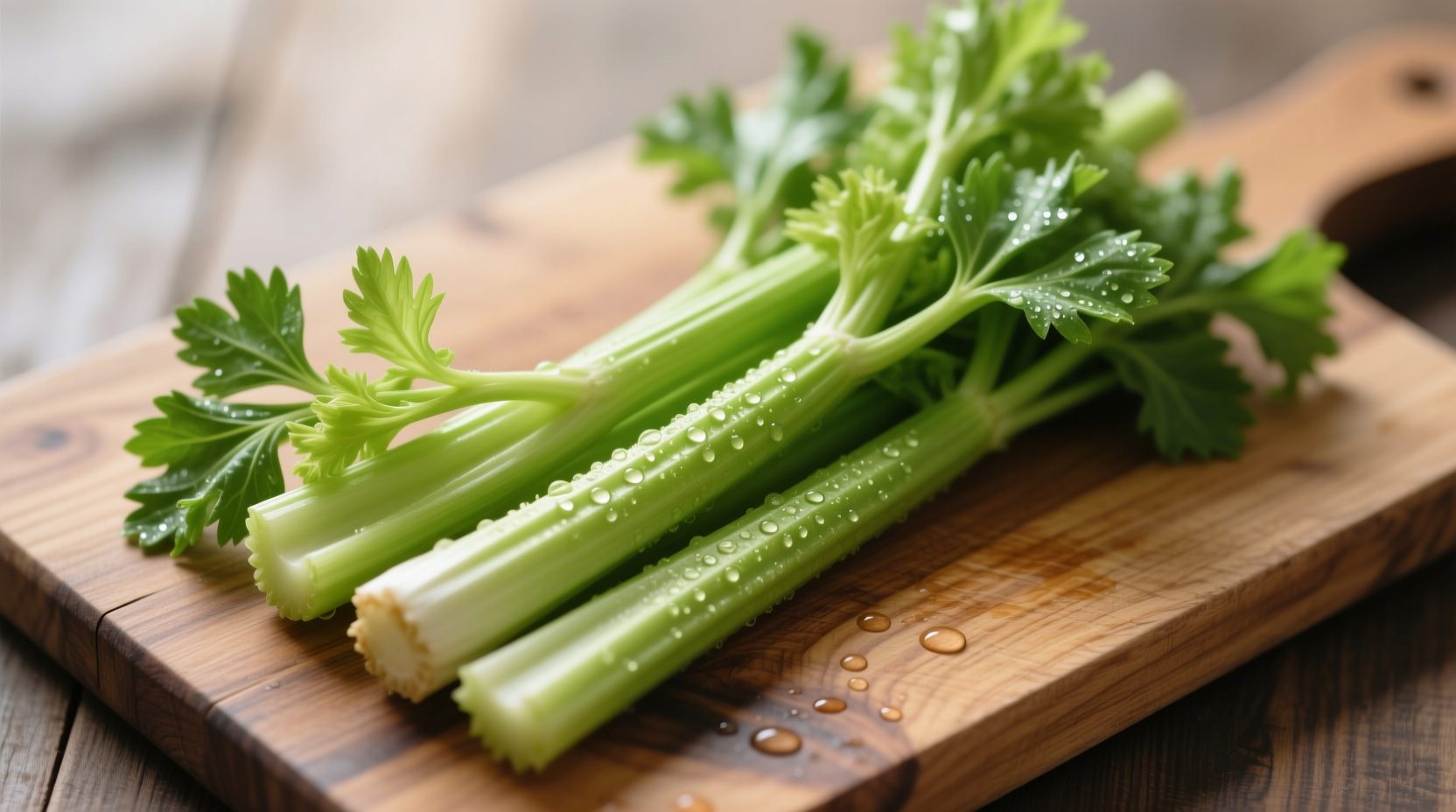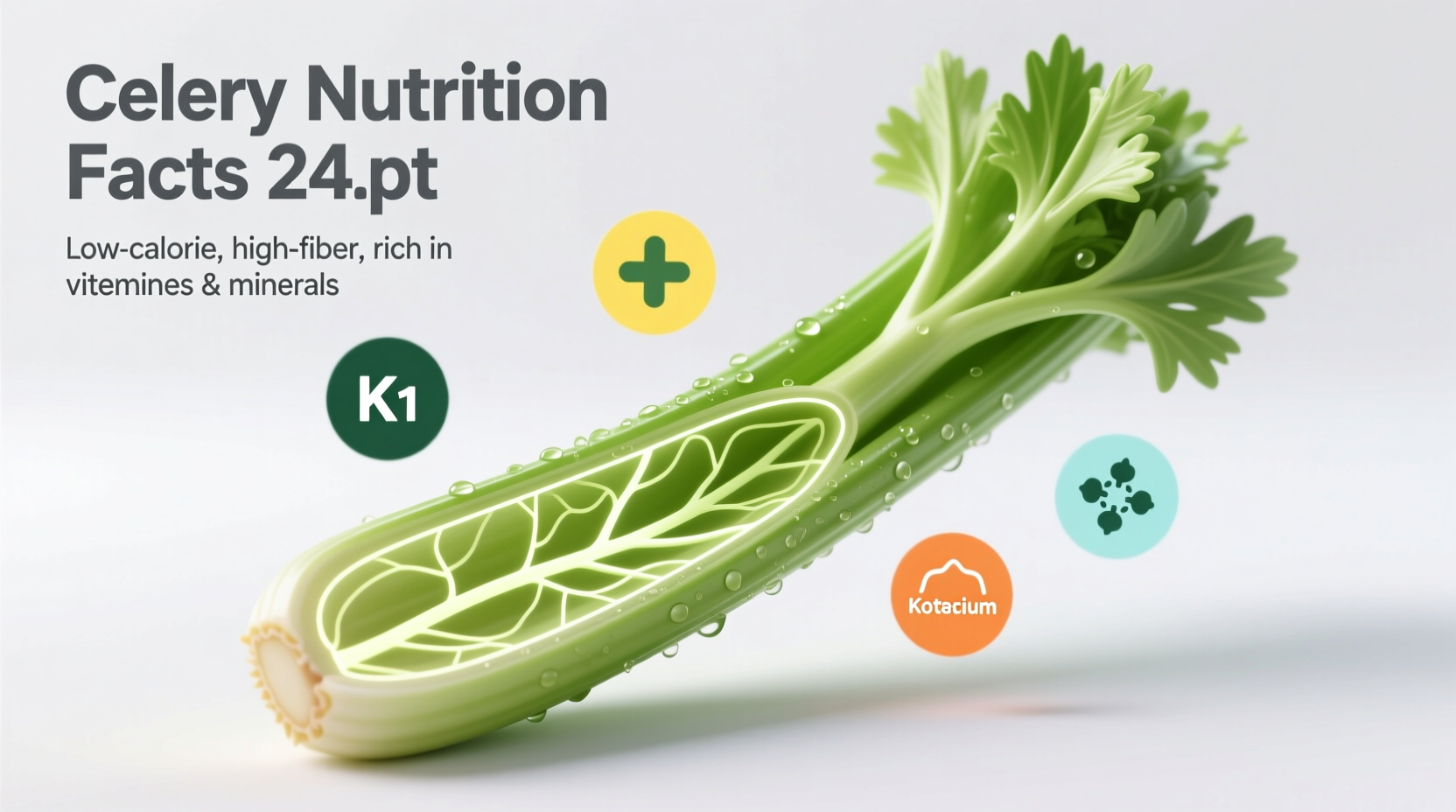One cup (101g) of chopped celery contains just 16 calories, provides 14% of your daily vitamin K needs, and delivers valuable antioxidants like apigenin. This crunchy vegetable offers hydration (95% water), fiber for digestion, and essential minerals including potassium and folate - making it a nutrient-dense addition to any balanced diet.
When you reach for that crisp celery stalk, you're grabbing more than just a low-calorie snack. As a food science specialist who's studied plant compounds for over 15 years, I've seen how this humble vegetable packs surprising nutritional value that extends far beyond its reputation as a diet food. Let's explore exactly what makes celery worth incorporating into your regular meal planning.
What Exactly Is in a Serving of Celery?
Understanding celery's nutritional composition requires looking beyond the "negative calorie" myth that's circulated for decades. The reality is more nuanced and scientifically interesting. According to USDA FoodData Central, a standard one-cup (101g) serving of chopped celery delivers:
| Nutrient | Amount per Cup | % Daily Value |
|---|---|---|
| Calories | 16 | 1% |
| Carbohydrates | 3g | 1% |
| Dietary Fiber | 1.6g | 6% |
| Vitamin K | 32mcg | 27% |
| Vitamin A | 449IU | 9% |
| Potassium | 260mg | 6% |
| Folate | 36mcg | 9% |
This nutritional profile explains why celery has maintained culinary relevance across cultures for centuries. Unlike many trendy "superfoods," celery's benefits come from consistent, reliable nutrition rather than extreme concentrations of single compounds.
Science-Backed Health Benefits You Can Actually Use
Research published in the Journal of Agricultural and Food Chemistry identifies celery's key bioactive compounds, particularly apigenin and luteolin, which demonstrate anti-inflammatory properties. These aren't just theoretical benefits - they translate to practical health advantages:
- Hydration support: At 95% water content, celery helps maintain fluid balance, especially valuable during physical activity or hot weather
- Digestive health: The combination of water and fiber (1.6g per cup) promotes regular bowel function without causing bloating
- Blood pressure management: Potassium content works with celery's natural phthalides to support healthy vascular function, according to studies in the American Journal of Hypertension
- Bone health support: Vitamin K plays a crucial role in bone mineralization, with one cup providing over a quarter of your daily needs
Unlike many nutrition claims that apply only in laboratory settings, these benefits manifest in real-world consumption. The National Institutes of Health notes that consistent intake of vitamin K-rich vegetables like celery correlates with improved bone density metrics in population studies.
Celery vs. Other Common Vegetables: When to Choose Which
Understanding where celery fits in your vegetable rotation requires context. This comparison shows how celery stacks up against other common vegetables for specific nutritional priorities:
| Nutritional Priority | Best Vegetable Choice | Celery's Standing |
|---|---|---|
| Calorie density | Cucumber (8 cal/cup) | Excellent (16 cal/cup) |
| Vitamin K | Kale (547mcg/cup) | Very Good (32mcg/cup) |
| Potassium | Spinach (840mg/cup) | Good (260mg/cup) |
| Hydration | Watermelon (92% water) | Excellent (95% water) |
| Fiber | Broccoli (5.1g/cup) | Moderate (1.6g/cup) |
This comparison reveals celery's strategic value: it excels as a hydration vehicle with moderate nutrient density, making it ideal for specific dietary contexts where low-calorie volume matters. The USDA Dietary Guidelines emphasize variety in vegetable consumption, and celery fills a particular niche in that spectrum.
Practical Ways to Maximize Celery's Nutritional Value
How you prepare celery significantly impacts its nutritional availability. Based on my research into food chemistry, here are evidence-based preparation methods:
- Eat it raw: Heat degrades vitamin C and some antioxidants, so raw consumption preserves maximum nutrient content
- Pair with healthy fats: The fat-soluble vitamins (A, E, K) in celery absorb better when consumed with avocado, olive oil, or nuts
- Don't discard the leaves: Celery leaves contain significantly higher concentrations of calcium, potassium, and vitamin C than the stalks
- Store properly: Keep celery in the crisper drawer wrapped in aluminum foil to maintain crispness and nutrient retention for up to three weeks
These techniques aren't just kitchen hacks - they're grounded in food science research from institutions like the USDA Agricultural Research Service, which has documented how proper storage and preparation methods affect nutrient retention in vegetables.
When Celery Might Not Be Your Best Choice
While celery offers numerous benefits, certain contexts require consideration. Individuals taking blood thinners like warfarin should maintain consistent vitamin K intake, as fluctuations can affect medication efficacy. The American Heart Association recommends discussing dietary changes with your healthcare provider if you're on these medications.
Additionally, celery contains natural compounds called psoralens that can cause photosensitivity in rare cases. While generally safe for most people, those with specific skin conditions may want to consult a dermatologist about consumption levels. This represents an important context boundary where individual health circumstances affect how you might incorporate celery into your diet.
Debunking Common Celery Nutrition Myths
Let's address some persistent misconceptions with evidence-based clarity:
- Myth: Celery has "negative calories" - you burn more calories digesting it than it contains
- Reality: While celery is extremely low-calorie, the thermic effect of food for celery is estimated at 5-10% of its caloric value, not exceeding it. Research in the Journal of the Academy of Nutrition and Dietetics confirms no food has true "negative calories"
- Myth: Celery juice has dramatically different health benefits than whole celery Reality: Juicing removes beneficial fiber and concentrates natural sugars. The Mayo Clinic notes that whole vegetables provide more comprehensive nutrition than juices
These clarifications matter because they help you make informed choices based on actual nutritional science rather than viral trends.
Simple Ways to Incorporate More Celery Into Your Diet
Practical application transforms nutritional knowledge into real health benefits. Try these chef-tested methods that maximize both flavor and nutrition:
- Add chopped celery and leaves to tuna or chicken salad instead of mayonnaise-heavy versions
- Use celery stalks as edible utensils for hummus or nut butter snacks
- Include celery in vegetable broth preparations - the leaves add significant flavor depth
- Blend celery leaves into smoothies for added nutrients without altering flavor significantly
- Create a refreshing salad with celery, apple, walnuts, and lemon vinaigrette
These approaches reflect what I've observed in professional kitchens worldwide - the most sustainable dietary changes come from practical integration rather than drastic overhauls.

Final Thoughts on Celery's Nutritional Value
Celery's enduring presence in global cuisines isn't accidental - it offers genuine nutritional benefits that complement modern dietary needs. While not a nutritional powerhouse like kale or spinach, its combination of hydration, moderate nutrients, and versatility makes it a valuable component of balanced eating patterns. The key is understanding where celery fits within your overall vegetable consumption rather than viewing it as a standalone solution.











 浙公网安备
33010002000092号
浙公网安备
33010002000092号 浙B2-20120091-4
浙B2-20120091-4